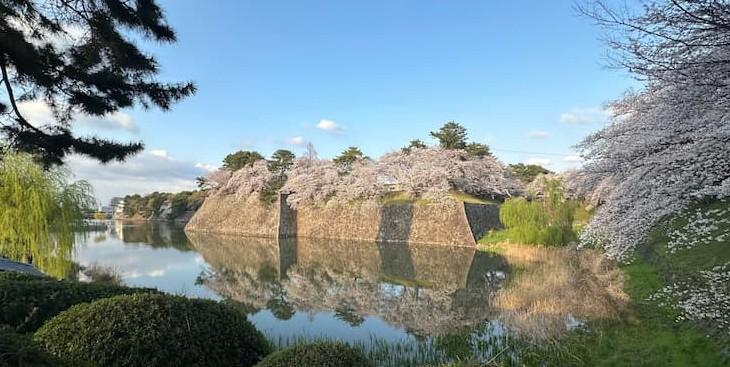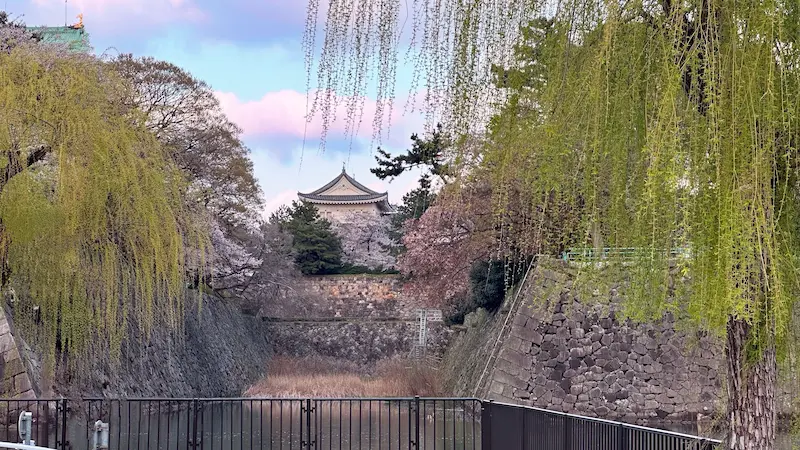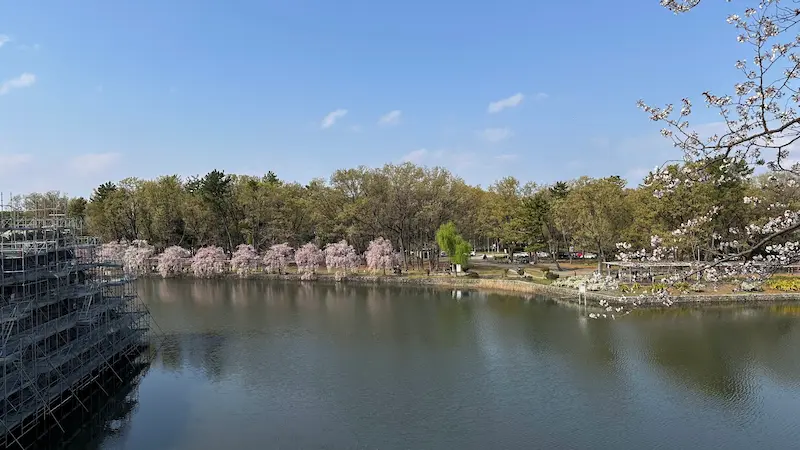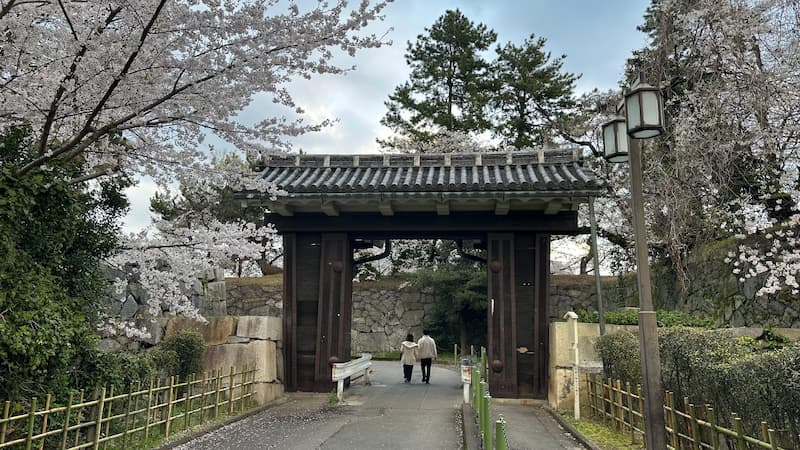Discover Hidden Historical Relics: Exploring Nagoya Castle’s Outer Perimeter
Along the inner moat of Nagoya Castle lie hidden historical sites that cannot be accessed from inside the grounds. Remnants like the Ninomaru Minami-yagura, Tsukimi-yagura, and the expansive Ofuke Moat tell the story of the castle’s defensive design and the daily life of its former inhabitants. Take a peaceful walk around the outer moat and experience the castle from a whole new perspective.
Ninomaru Minami-yagura Ruins

🏛 Overview
The Ninomaru Minami-yagura Ruins are located in the southwestern corner of the Ninomaru compound. The term “Minami” (south) indicates the direction, signifying that the turret once stood in the southwest corner for strategic defense purposes.
Although the original structure was lost to war damage and urban development during the Meiji era, remnants of the stone foundations remain, offering a glimpse into Edo-period fortification.
🗺 Address
1-1 Honmaru, Naka-ku, Nagoya City, Aichi Prefecture – Within Nagoya Castle Grounds
🚶 Access
Approx. 3-minute walk (270m) from the Imperial Gift Stone Monument
⏳ Visiting Time Estimate
- Quick Visit: ~3 minutes
- In-Depth Visit: ~10 minutes
📍 Highlights
- Stonework Foundations: Observe the remaining base stones and imagine the former turret’s structure.
- Lush Surroundings: The greenery-rich paths create a tranquil atmosphere.
- Seasonal Views: Cherry blossoms bloom beautifully here in spring.
📌 Trivia
- Historical Function: This turret was critical for defending the castle’s west flank.
- Hidden Gem: While the turret no longer stands, the stone foundations attract dedicated history buffs.
- Famous Figures: Part of the original castle plan commissioned by Tokugawa Ieyasu.
Tsukimi-yagura Ruins

🏛 Overview
The Tsukimi-yagura (Moon Viewing Turret) once stood at the northwest corner of the Ninomaru area. True to its name, it served not just for defense but also as a place for moon gazing, blending military function with elegance.
Destroyed in the 1945 air raids, only the stone base remains today.
🗺 Address
1-1 Honmaru, Naka-ku, Nagoya City, Aichi Prefecture – Within Nagoya Castle Grounds
🚶 Access
Approx. 2-minute walk (140m) from the Minami-yagura site
⏳ Visiting Time Estimate
- Quick Visit: ~3 minutes
- In-Depth Visit: ~10 minutes
📍 Highlights
- Stone Base Remains: Offers insight into the craftsmanship of castle builders.
- Scenic Walkways: Surrounded by green trails ideal for strolling.
- Seasonal Views: Cherry blossoms enhance the landscape in spring.
📌 Trivia
- Cultural Function: Uniquely designed to also serve as a leisure space for moon viewing.
- Hidden Spot: A peaceful and often-overlooked stop for visitors.
- Famous Figures: Part of the castle complex planned under Tokugawa Ieyasu.
Ofuke Moat (Ofuke Ōhori)

🏛 Overview
Located on the north side of Nagoya Castle, the Ofuke Moat was a massive defensive water feature. Not only did it deter intruders, but it also served as an emergency escape route for the feudal lord via a secret gate (Uzumi Gate), leading to a dry moat and onto boats crossing the Ofuke Moat.
The area once featured the grand Ofuke Garden with a large lotus pond covering the southern half.
🗺 Address
1-1 Honmaru, Naka-ku, Nagoya City, Aichi Prefecture – Ofuke Moat Area
🚶 Access
Approx. 7-minute walk (550m) from Tsukimi-yagura
⏳ Visiting Time Estimate
- Quick Visit: ~3 minutes
- In-Depth Visit: ~15 minutes
📍 Highlights
- Panoramic Moat Views: Feel the scale and defensive significance of the moat.
- Uzumi Gate Remains: Learn about the secretive escape routes built into the castle design.
- Seasonal Views: Cherry blossoms reflected on the water surface create a serene spectacle.
📌 Trivia
- Survival Route: Planned as a strategic escape path for the castle lord.
- Local Life: Once flanked by dyeing factories and fishing spots for locals.
- Strategic Asset: An essential piece of Nagoya Castle’s outer defense system.
Statue of Katō Kiyomasa by Shizuo Takafuji

🏛 Overview
This bronze statue honors Katō Kiyomasa, a famed warlord and master castle architect who played a major role in constructing Nagoya Castle. It was created in 1979 by renowned Nagoya-born sculptor Shizuo Takafuji, commemorating the 80th anniversary of Kagome Co., Ltd., which donated the statue to the city.
🗺 Address
1-1 Sannomaru, Naka-ku, Nagoya City – South of Nagoya Noh Theater
🚶 Access
Approx. 15-minute walk (1.1 km) from Ofuke Moat
⏳ Visiting Time Estimate
- Quick Visit: ~5 minutes
- In-Depth Visit: ~15 minutes
📍 Highlights
- Dramatic Pose: Captures Kiyomasa carrying a massive stone, symbolizing his construction prowess.
- Nearby Theater: Located beside the elegant Nagoya Noh Theater.
- Seasonal Views: Surrounded by beautiful cherry blossoms in spring.
📌 Trivia
- Corporate Patronage: Donated by Kagome in honor of its 80th anniversary.
- Artist’s Legacy: Other statues by Takafuji of Katō Kiyomasa also exist, including one at Kumamoto Castle.
- Historical Importance: Kiyomasa was a chief architect of many Japanese castles, including Nagoya.
Ninomaru Main Gate (Ōte Ninomon / Nishitetsumon)

🏛 Overview
Also known as the Nishitetsu Gate, the Ōte Ninomon served as the outer gate of the main Ninomaru entrance, paired with the now-lost Ōte Ichinomon. Built around 1612 in the Kōraimon architectural style, it was a key access point between the Sannomaru and Ninomaru areas.
In 1975, it was designated an Important Cultural Property and remains one of the few original Nagoya Castle structures.
🗺 Address
Ninomaru 1, Naka-ku, Nagoya City, Aichi Prefecture
🚶 Access
Approx. 7-minute walk (500m) from the Katō Kiyomasa Statue
⏳ Visiting Time Estimate
- Quick Visit: ~3 minutes
- In-Depth Visit: ~15 minutes
📍 Highlights
- Architectural Form: Observe the classic Kōraimon-style design.
- Cultural Insight: Learn about Edo-period gate construction and function.
- Seasonal Views: Blossoming cherry trees complement the gate beautifully in spring.
📌 Trivia
- Bustling Past: Once the main gateway for traffic between Sannomaru and Ninomaru.
- Rare Legacy: Among the few surviving structures from the castle’s original construction.
- Famous Figures: Integral to Tokugawa Ieyasu’s grand vision for Nagoya Castle.


comment